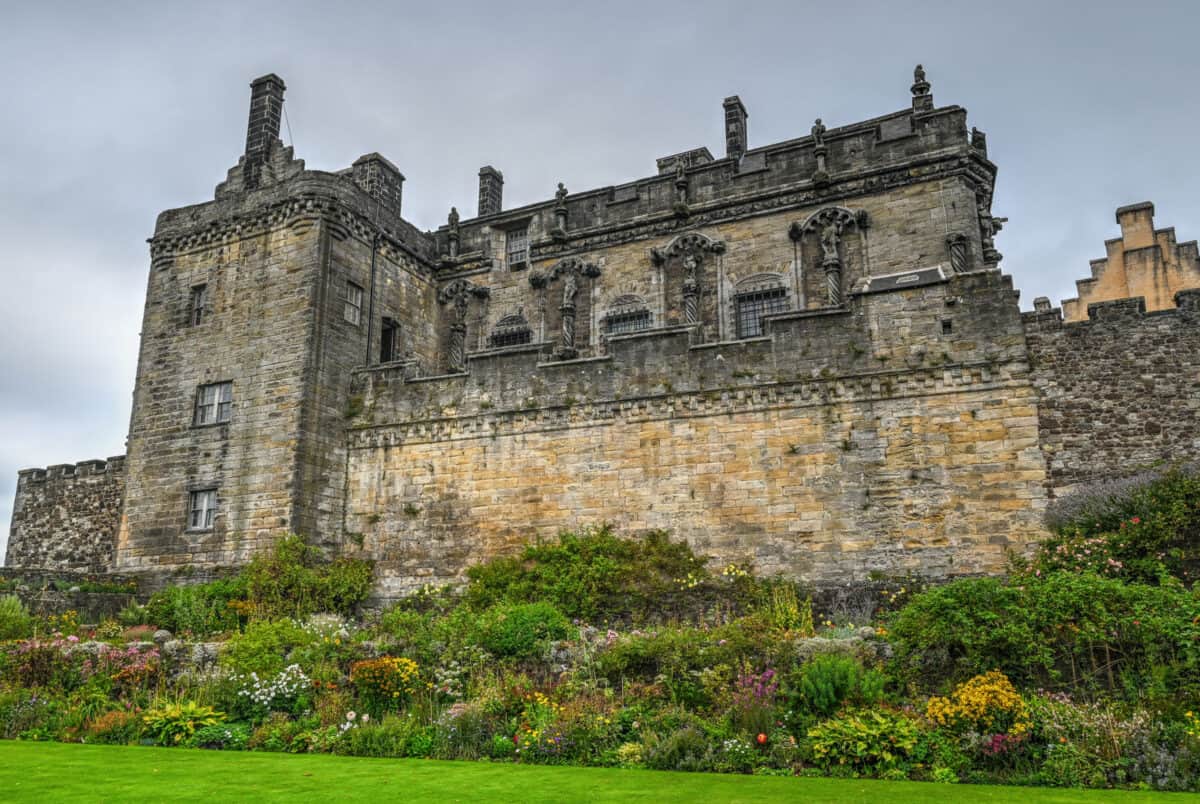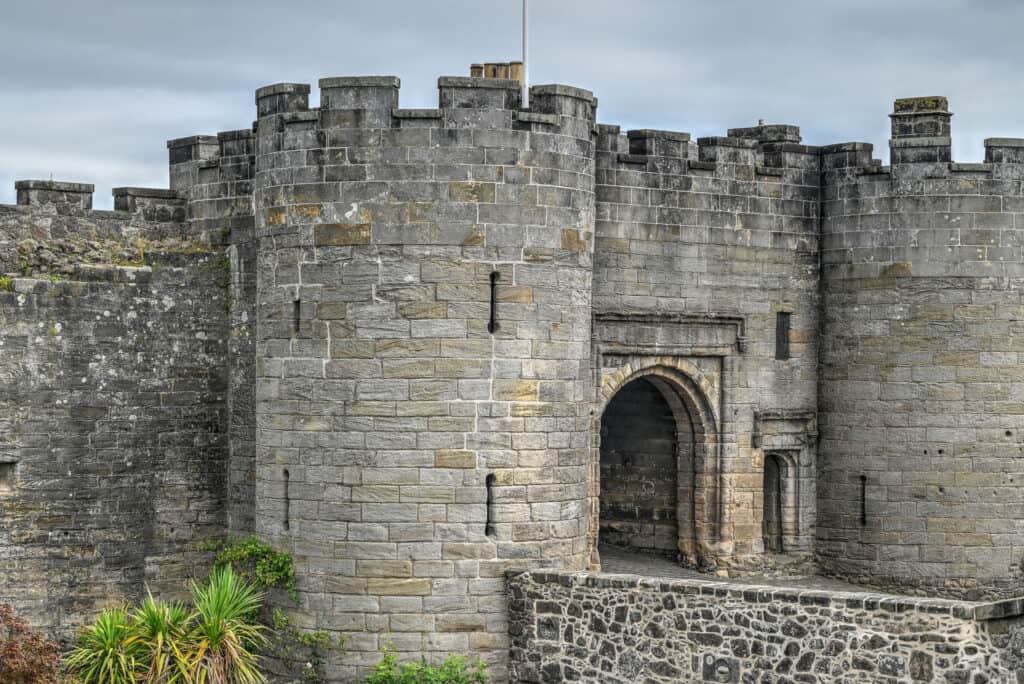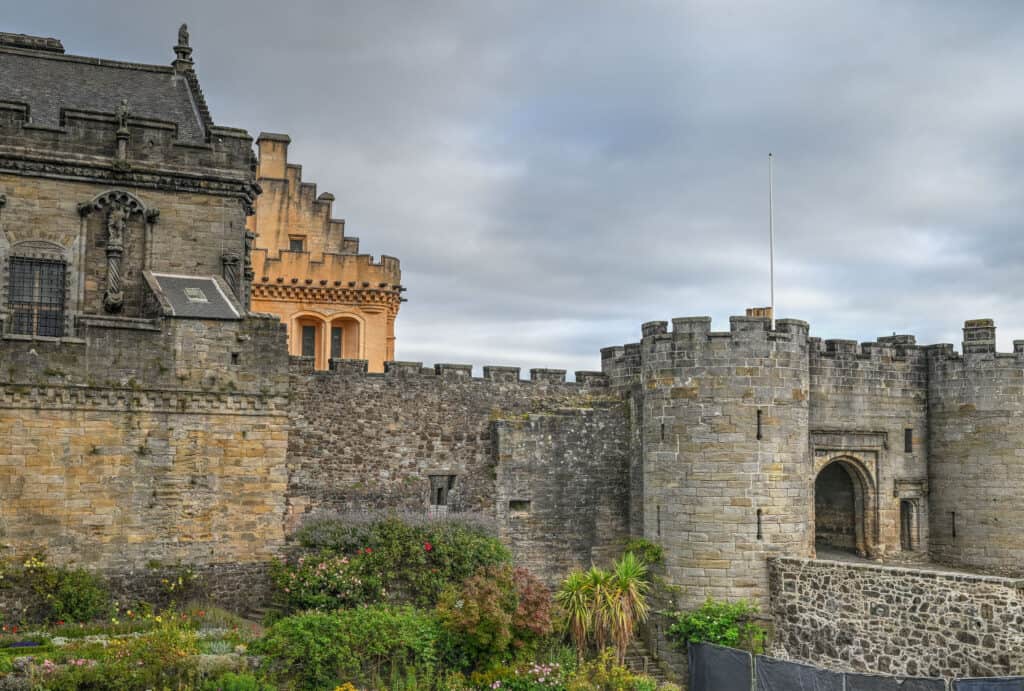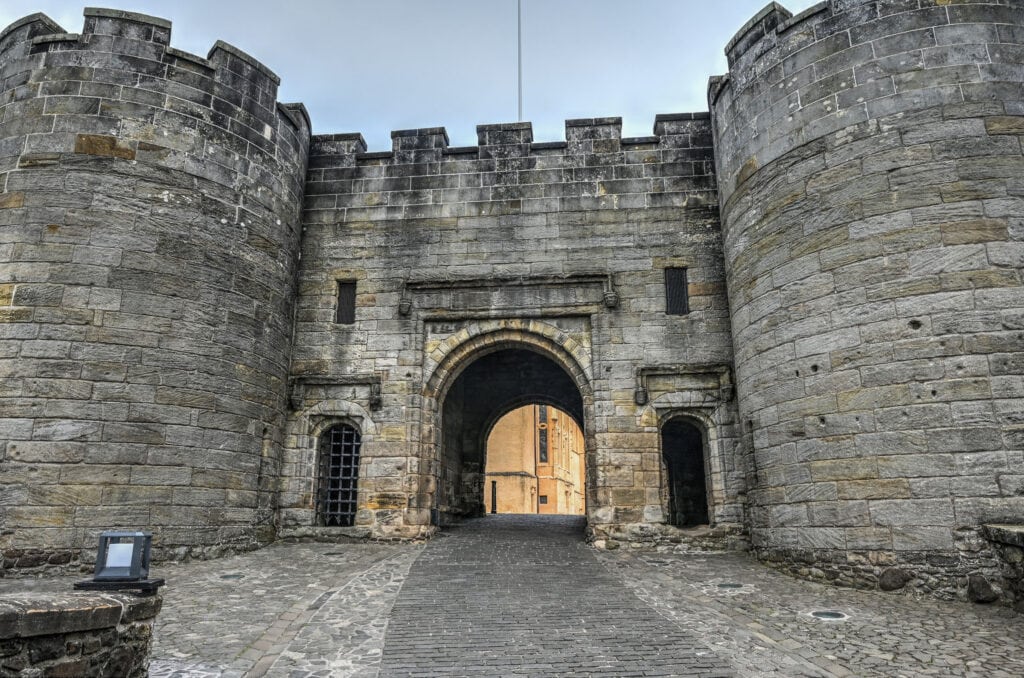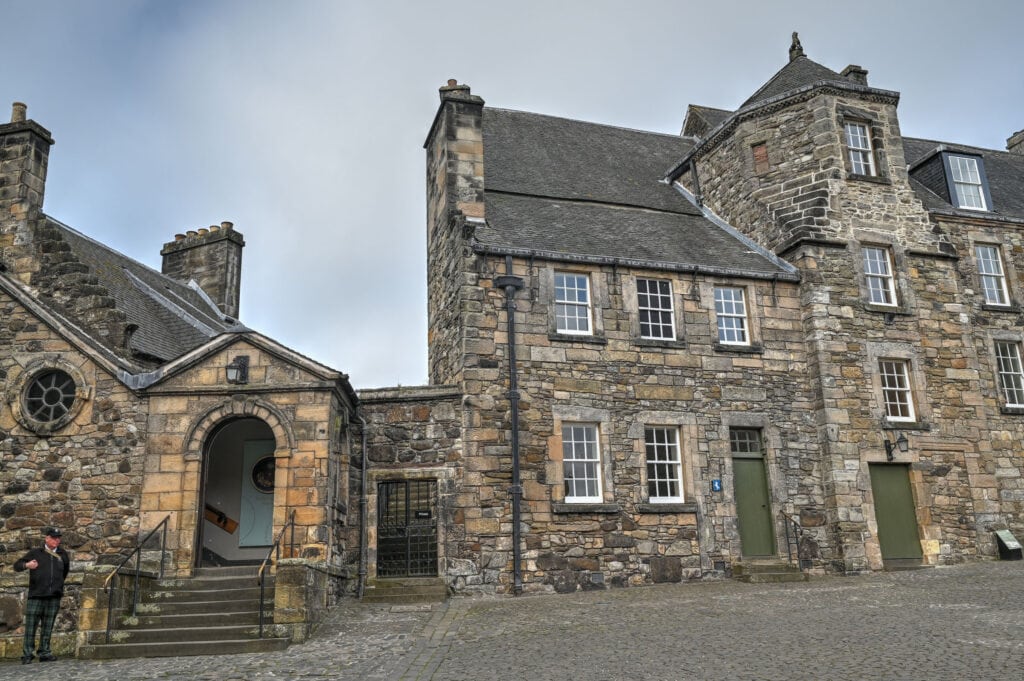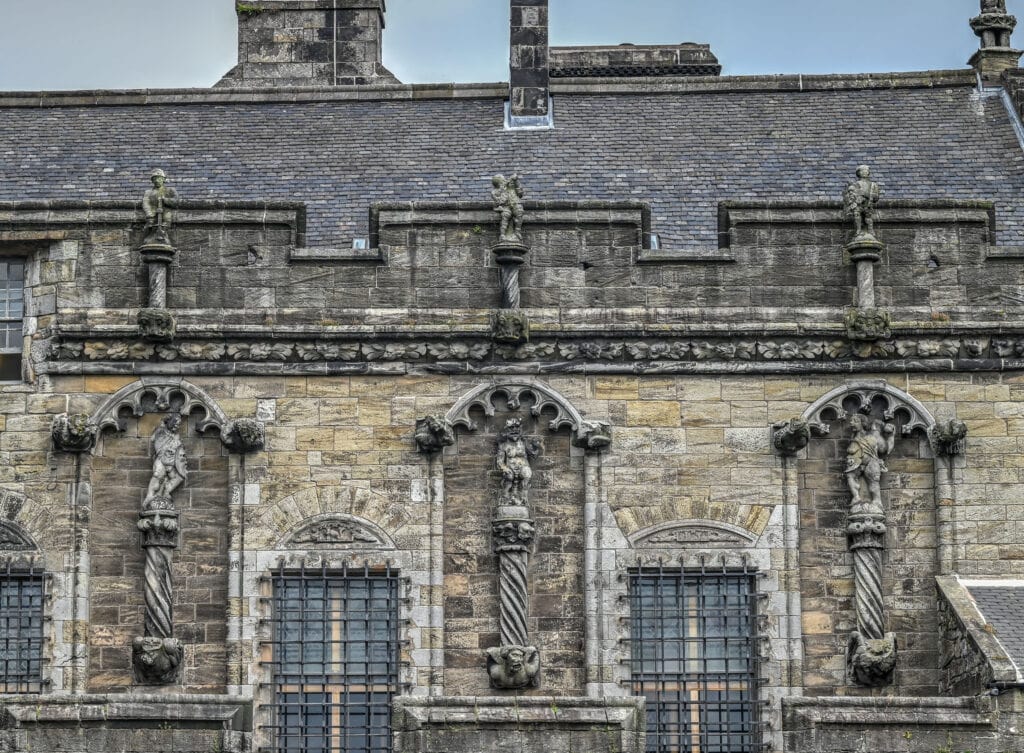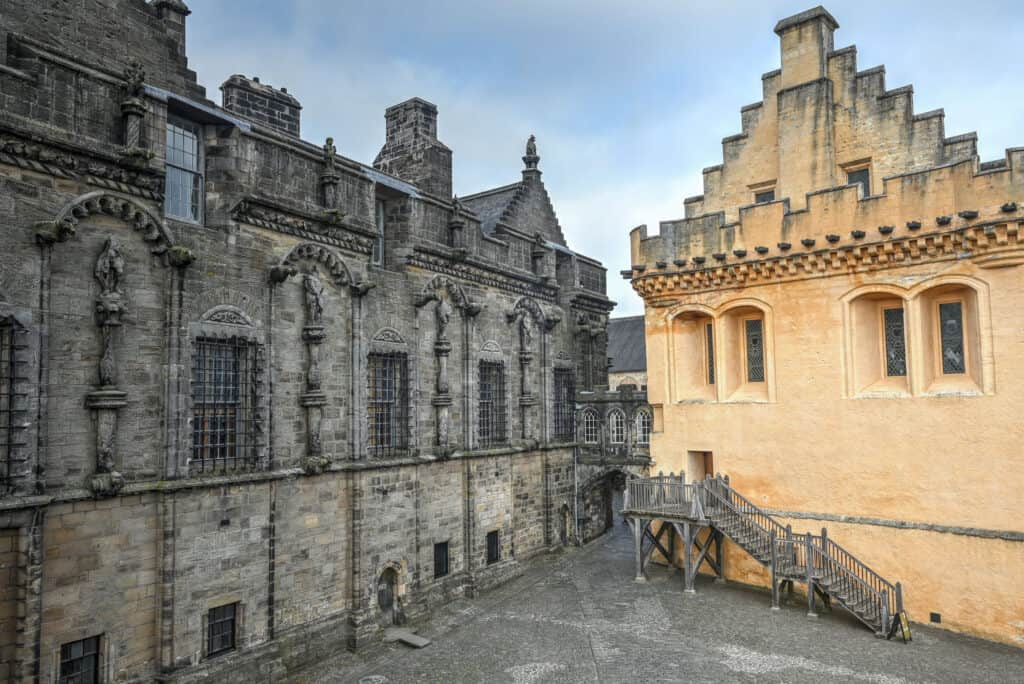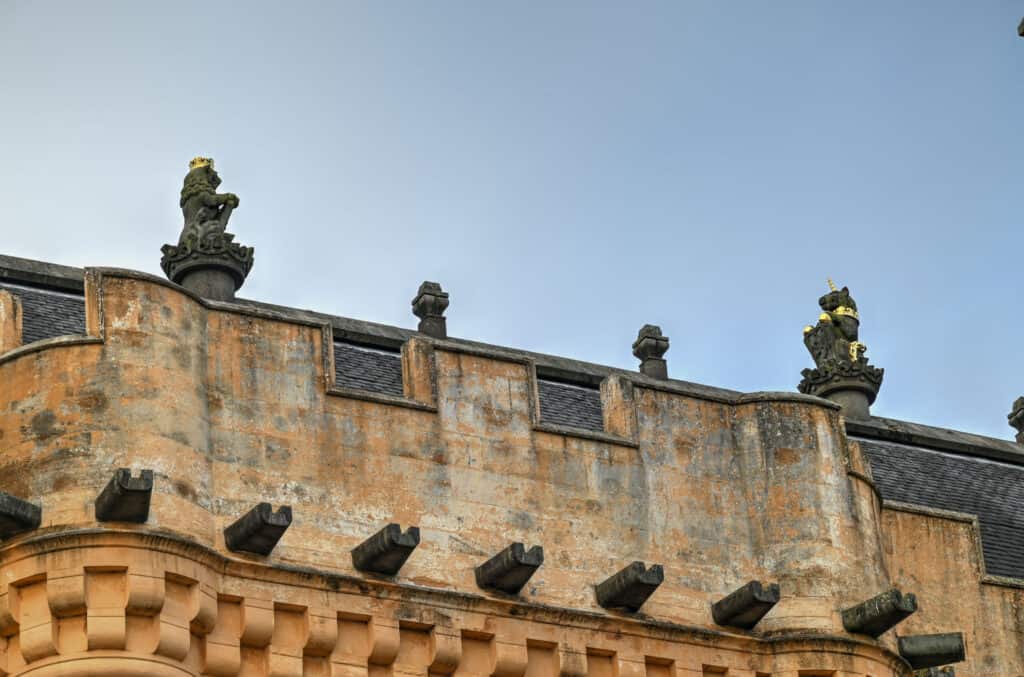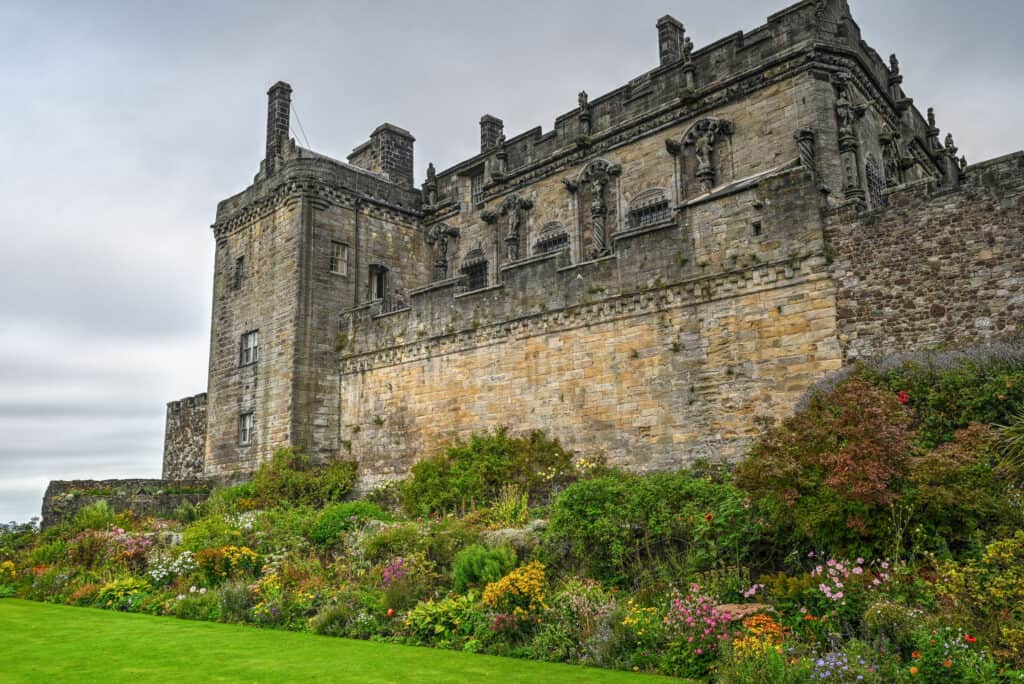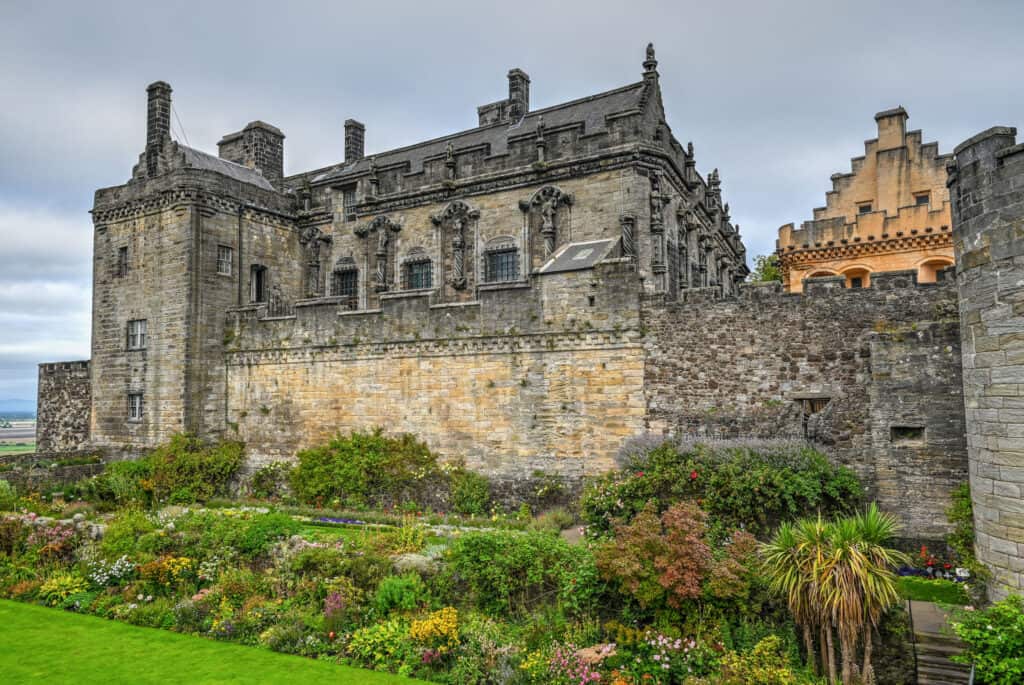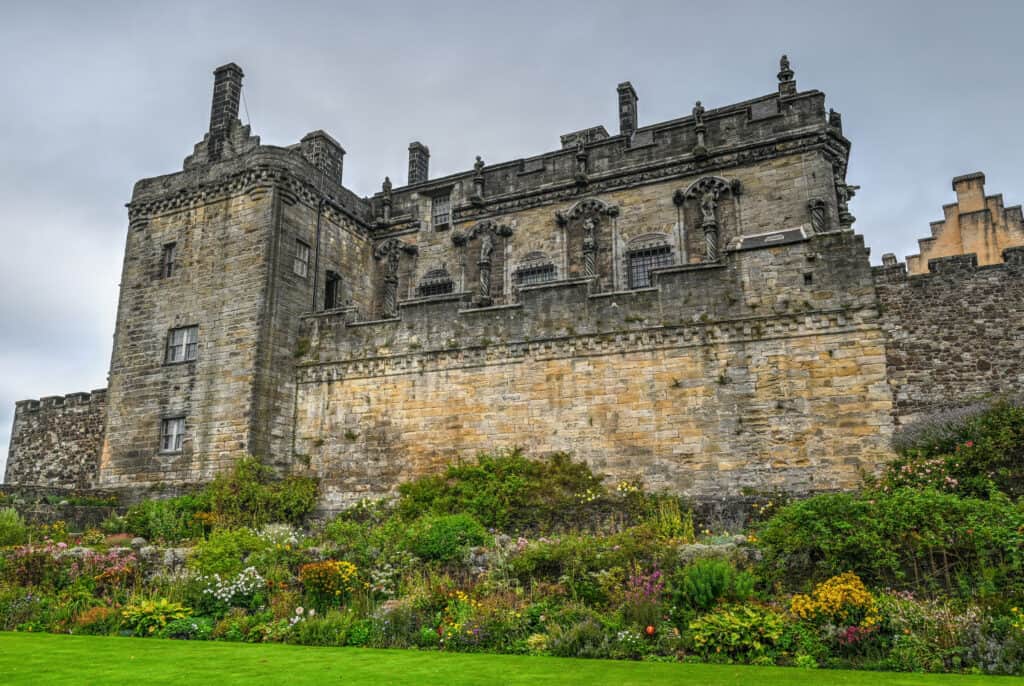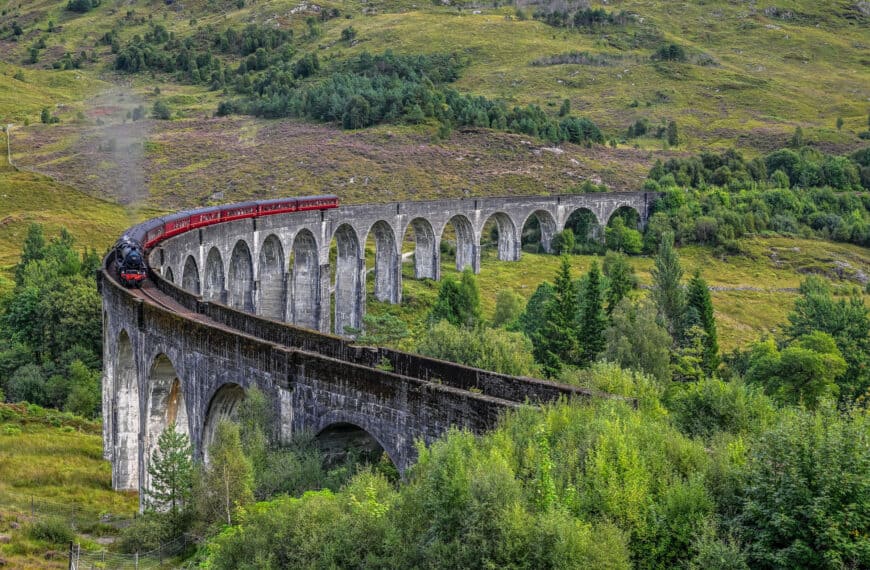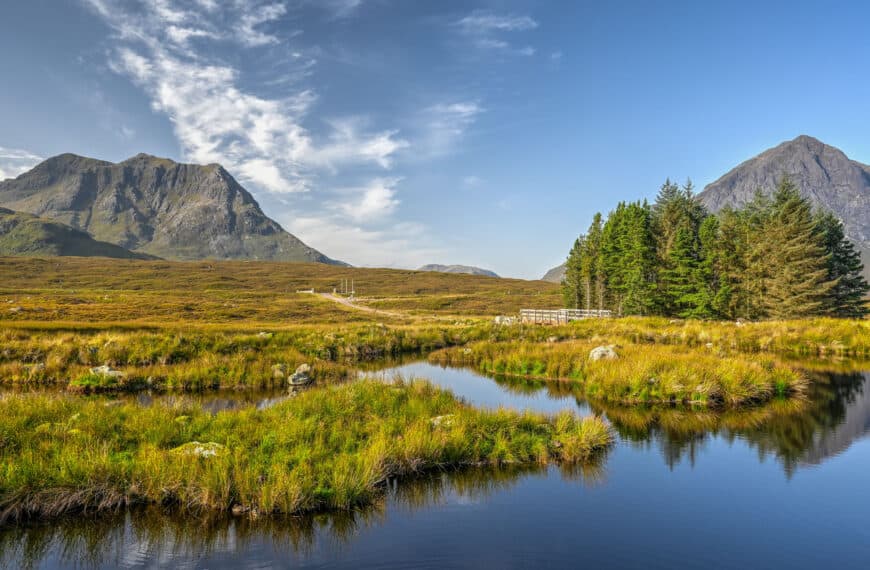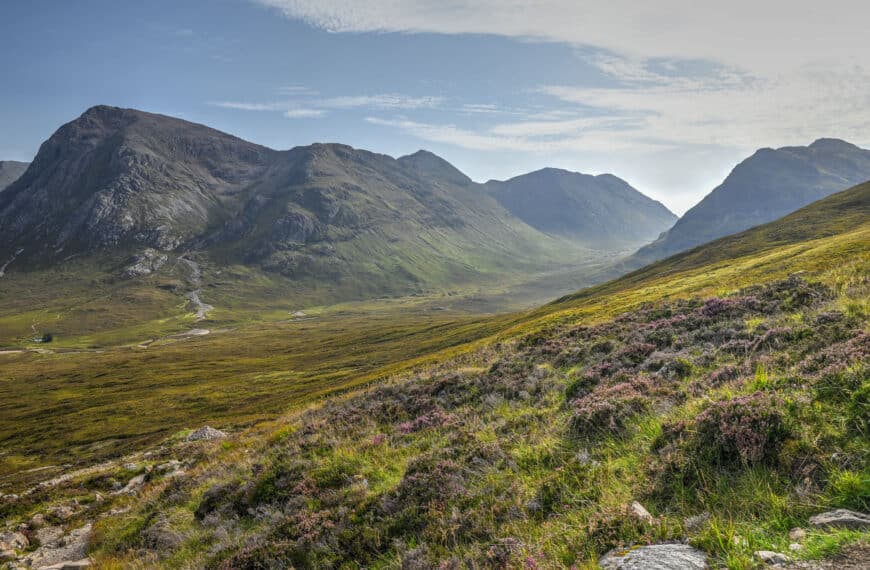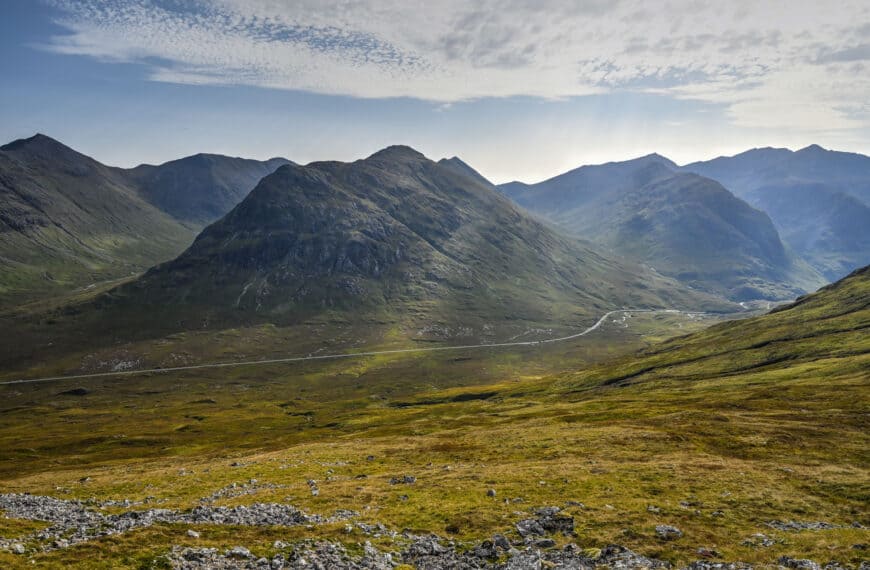The large and imposing Stirling Castle is one of the most historically and architecturally important castles in Scotland. Located in the town of Stirling, the castle was our favorite Castle to visit in Scotland. The architecture is stunning, the history fascinating, the surrounding scenery enchanting, the guided tour captivating, and the castle receives nowhere near the crowds seen at Edinburgh Castle. Before the union with England, Stirling Castle was also one of the most used of the many Scottish royal residences, very much a palace as well as a fortress. There have been at least eight sieges of Stirling Castle, including several during the Wars of Scottish Independence, and most of the present-day castle buildings date from the fifteenth and sixteenth centuries. Mary Queen of Scots spent most of her life here, and William Wallace took back the castle for Scotland in the Battle of Stirling Bridge. Below we present our Stirling Castle Visiting Guide, which includes information on how to get to the Castle and how to make the most of your time there. Located a short distance from both Edinburgh and Glasgow, it makes for an excellent day trip from either city.
Disclosure: This page (Stirling Castle Visiting Guide) may contain product affiliate links. At no additional cost to you, we may receive a commission for purchases made through these links. More details can be found on our disclosure and policies page.
You might also be interested in these pages (coming soon):
Best Day Trips From Edinburgh
Best Things to See and Do in Edinburgh
Best Things to See and Do on a Road Trip Between Edinburgh and Skye
Best Castles to Visit Near Edinburgh





Location of Stirling Castle
Sterling Castle is located 65 km from Edinburgh, which translates to about a 60-minute drive away, and is located 48 km from Glasgow, about a 35-minute drive away.

The quickest way to reach the Castle is with your own vehicle. For advice and tips on how to drive in Scotland, check out our Scotland Roadtrip Driving Guide.
If you haven’t booked your rental vehicle yet, we highly recommend using Discover Cars to get the best rates on your rental in Scotland.
Stirling can easily be reached by train from Edinburgh (40 minutes) or from Glasgow, but the train station is a 15-minute uphill walk to the castle.
History of Stirling Castle
Stirling Castle is one of the largest and most historically and architecturally important castles in Scotland. Sitting atop a rocky volcanic outcrop in Stirling and surrounded on three sides by steep cliffs gave the castle a strong defensive and strategic position, from which it was able to control traffic along the River Forth below. Occupying this important position between the Scottish Lowlands and Highlands, the castle has often been described as the ‘brooch’ that joins the two halves of Scotland together.
Although there is evidence suggesting that fortifications may have been built on the hilltop as early as 2000 years ago, possibly by the Celtic Votadini or Maetae tribes, the first record of Stirling Castle dates from around 1110 when King Alexander I dedicated a chapel there. Around the same time, buildings and courtyards were constructed within the already-old ramparts and earthworks. By the mid-12th Century, the castle had become a key royal administrative centre.
Wars of Independence and the Battle of Stirling Bridge
Sterling Castle’s important strategic position between the lowlands and the highlands was a big reason why the castle would play such a key role in various conflicts. The most famous of these were the Wars of Scottish Independence in the late 13 century. When the Scottish nobility negotiated a treaty with France against England, King Edward of England invaded and captured Stirling Castle. Within the following year, however, led by legendary William Wallace and Andrew Moray, the Scots won the castle back against a much larger English army in the Battle of Stirling Bridge.
Battle of Falkirk and Battle of Bannockburn
Unfortunately, this victory was short-lived. The following summer, after a crushing defeat at the Battle of Falkirk, the Scots gave the castle up to the English once more. Although King Edward of England strengthened the castle, it was besieged in 1299 by Scottish forces including Robert Bruce (who would later become the King of Scots). The castle traded hands a few more times between the English and the Scot, until the Battle of Bannockburn in 1314, the most important military victory in Scottish history.
In the aftermath of the famous bloody battle, King Robert the Bruce ordered all of the defences to be destroyed so they could never be used against his efforts again.
Castle refurbishments and Mary Queen of Scots
Stirling Castle benefitted from a great refit in the early 16th century during the reign of James IV of Scotland and his successors, which started to give the castle much of the look it has today. He built the King’s Old Building as his residence, along with a new Great Hall, the Royal Chapel, an inner courtyard, and a massive new main gate with twin circular towers were built. The coronation ceremony for his granddaughter, Mary Queen of Scots, who was only six days old at the time. took place in Sterling Castle in 1543. Mary spent much of her youth and adulthood in the castle.
Following James VI’s coronation as the king of England in 1603 and subsequent move to London, Stirling Castle had now seen its last days as a primary royal residence. The castle’s strategic value, however, was not missed by commanders during subsequent wars. In 1651 the castle fell to a siege by forces loyal to Oliver Cromwell (dents from cannonballs fired during this attack can still be seen today around the main gate). The castle yet again found itself under siege during the Jacobite Rising of 1745-1746, intending to restore the Stuart line to the throne. A force led by Bonnie Prince Charlie attempted to take the castle but was unsuccessful thanks to Stirling’s recently improved artillery defences.
The castle then functioned primarily as an army barracks from the mid-18th century until 1964. Today, Stirling Castle, like many others across the country, is now in the care of Historic Environment Scotland.
Visiting Stirling Castle
Parking
There is a large car park by the castle (maximum four hours – £4.00), but it can get quite busy and is occasionally full. If this occurs, you can use city centre parking or the Castleview Park and Ride Service (get off at the Old Town Jail, which is a 5-minute walk from the castle entrance).
Facilities
Toilets, a gift shop and a café are located just inside the main gate.
Opening Hours (2024)
(29 Mar to 30 Sep) Daily 9:30 am to 6 pm (last entry at 5 pm)
(1 Oct to 28 Mar) Daily, 9:30 am to 5 pm (last entry 4 pm)
Ticket Prices
Castle & Gardens (£17.50 for adults, £10.50 for children).
There are also reduced fares for seniors and discounted family tickets are also available.
You can visit this historic building with Scotland’s Explorer Pass
If you plan on visiting multiple Castles and Historic Buildings in Scotland, you might want to consider getting the Explorer Pass from Historic Environment Scotland.
The Explorer Pass costs £35 for adults and £21 for children. You can purchase your Explorer pass online here.
The pass is valid for 14 consecutive days.
The pass includes entry to all Historic Environment Scotland properties, which include Edinburgh Castle, Stirling Castle, Doune Castle, Urquhart Castle, St Andrews Castle, St Andrews Cathedral, Iona Abbey, Melrose Abbey, Fort George, and many more.
Important: To guarantee site entry, you should still pre-book your desired property visits (dates and timeslots).
Exclusions: Explorer passes do not include access to properties in the care of The National Trust for Scotland, The Palace of Holyroodhouse and Holyrood Abbey in Edinburgh, or properties in the care of private trusts.
Very occasionally a property may have to close at short notice due to adverse weather conditions or other reasons such as planned renovations. Please check the Historic Scotland closures page for any unexpected site closures.
Booking ahead
It is recommended to book online in advance to guarantee entry, as you must select a date and a time slot for your visit. This is also true for Explorer Pass holders, you won’t have to pay online but you still have to select a time slot for your visit.
The castle can accommodate some walk-ups, but these are subject to on-site availability. When tickets are sold out online there will be no further walk-up tickets available.
Exploring the Castle
The castle can be visited in three different manners: on your own, with an audio guide (using your own mobile device with internet access- it can be pre-booked when you purchase your tickets online (see above), or with a guided tour. Guided tours are included in the ticket price and take place every half hour between 10 am and 3 pm.
We don’t always take part in guided tours when we visit castles, but we did here and we thoroughly enjoyed it. The storytelling was excellent and the historical anecdotes very interesting, bringing the castle’s stories to life – we definitely learned a lot while having fun! The tour lasts about 45 minutes and it doesn’t cover the entire castle, leaving a few areas for you to explore on your own.
Stirling Castle Map and Buildings

1- Main Entrance
2- Guardroom square. Toilets, gift shop and ticket counter can be found here.
3- Castle Main Gate
4- Location of the Unicorn Café
5- Queen Anne Garden
6- The Royal Palace
7- King’s Old Buildings and the Regimental Museum
8- The Great Hall (bottom, yellow); The Chapel Royal (right)
9- Nether Bailey
Key Rooms and Buildings to Visit
Stirling Castle Great Hall
The Stirling Castle Great Hall is a grand medieval banquet hall and the largest of its kind to ever be built in Scotland. The Great Hall boasted five fireplaces and four spiral staircases in each corner. The impressive hammer-beam roof is a modern reconstruction, modelled on the early 16th-century roof at Edinburgh Castle. It is made of 400 local oak trees joined by wooden pegs.



Since 1999, after a decadelong restoration effort that altered the building inside and out, the Great Hall of Stirling Castle was transformed into what it looked like (based on the evidence available) 300-400 years in the past and was painted in a bright golden yellow color. This is because, in its prime, the Great Hall was coated with a yellow ochre layer of lime wash, which was meant to mimic the colour of gold and royalty.
The Royal Palace
This is where you will find the King and Queens apartments, which are colourfully decorated as they might have been in the mid-16th century. Here you will also find costumed performers playing the role of palace attendants. During your visit, take the time to admire the intricate tapestries decorating the walls, which are recent recreations using the original 15th-century methods.






The Great Kitchens
The Great Kitchens are one of the areas not covered in the guided tour and they were lots of fun to explore. They display what the castle kitchens would have looked like back in the day, complete with an array of mannequins.



The Chapel Royal
This chapel was one of the first protestant churches built in Scotland, in 1594. Admire the exquisite stained glass windows and marvel at the intricate wood carvings that adorn this once-sacred space.
The North Gate
The North Gate is the oldest surviving part of Stirling Castle. Originally a gatehouse built in 1381 for King Robert II, grandson of Robert the Bruce. In 1511-1512 when the building was expanded to provide kitchens for the great hall, the upper floors were removed.


Castle Battlements
The battlements were built in the early 18th century long after the castle’s glory days and in response to early Jacobite Rebellions. From up here, the castle’s strategic position is quite evident as defenders had 360-degree panoramic views of enemy armies. Today it’s a wonderful place to enjoy the panoramic views of the surrounding landscape.
Ramparts and Grand Battery
More beautiful distant views of the surrounding landscape can be had from here, where cannons were used to threaten invading armies. Also, notice the towering Wallace monument (William Wallace) in the distance.


Castle Gardens
Once you cross the main gate, the first thing you will notice to your left is a beautiful grassy courtyard called the Queen Anne Garden, which was the Royal family’s playground in the 1600s.
Stirling Castle on the Silver Screen
You might find it interesting to know Sterling Castle has appeared in several movies and TV series, particularly in recent years. Here are a few examples :
- Mary Queen of Scots (2018): starring Saoirse Ronan and Margot Robbie
- Outlaw King (2018): starring Chris Pine as King Robert the Bruce
- The 39 Steps (2008)
- Kidnapped (1971): starring Michael Caine as Jacobite rebel Alan Breck
- Burke & Hare (2010): comedy starring Simon Pegg and Andy Serkis
Random Sterling Castle Facts
First flight: In 1507, the very first record of an attempted flight took place on the walls of Sterling Castle. John Damian, an Italian alchemist in attendance at the court of James IV, believed that with the aid of feathered wings, he would be able to take flight. Of course, his attempt to jump from the battlements failed spectacularly and instead, John landed in a dunghill and broke his thigh bone.
Oldest soccerball: the oldest surviving football in the world was discovered Behind the panelling in the Queen’s chamber, which was decorated in the 1540s. Mary Queen of Scots was there at this time and later in life was known to have an interest in all sports, especially soccer. The ball itself was found in 1981 and can be seen in The Stirling Smith Art Gallery & Museum. The ball was made from an inflated pig’s bladder, wrapped with cow’s hide and is around half the size of footballs today.
Nearby Sights and Activities
Blackness Castle
Blackness Castle is an impressive 15th-century castle beautifully positioned along the shores of the Firth of Forth, in Scotland. Often referred to as ‘the ship that never sailed’ due to its great stone ship appearance, these days the castle is known by many for its use as the setting for Fort William in Outlander. A very interesting castle to visit, and rarely as busy as some other more well-known castles in Scotland.





Blackness Castle is just a 40-minute drive from Sterling Castle. For more information on visiting this castle, check out our Blackness Castle Visiting Guide.
The Kelpies at Falkirk
Unveiled in 2014, standing just under 100 feet tall, and located within a community park known as The Helix, these giant horse sculptures quickly became a symbol of the town of Falkirk and the surrounding region. These beautiful sculptures are based on mythical water horse creatures known in Scotland as Kelpies and also pay homage to the Clydesdale workhorses that in the past would pull barges along the canal. Though many just make a quick stop at the Kelpies, there’s much to do here to keep you longer, including guided tours of the Kelpie interiors and beautiful walking trails along the canals.





The Kelpies are just a 30-minute drive from Stirling Castle. For more information on visiting this attraction, check out our Kelpies Visiting Guide.
Doune Castle
An imposing 14th-century courtyard castle in Doune, with a striking 100-foot high gatehouse and one of the best preserved great halls in Scotland. You are very likely to have seen Doune Castle in film or on TV, as it has been heavily featured in Month Python, was used as the Winterfell castle in the Game of Thrones pilot episode and has served as Castle Leoch in Outlander.





Recent research has shown that Doune Castle was originally built in the thirteenth century, then probably damaged in the Scottish Wars of Independence, before being rebuilt in its present form in the late 14th century. Doune Castle is just a 15-minute drive from Sterling Castle.
Highland Cows at Callander
A great spot to observe and take pictures of the famous Highland Cows (or the Hairy Coos as they are often referred to) is at the Trossachs Woollen Mill. This lovely gift shop is also home to three lovely hairy coos that you can visit and even feed if you would like! There’s also a small café on site.





The pictures shown above were taken from a farm along the side of the road, not far north from where the Trossachs Woollen Mill is located. However, since it wasn’t signposted or advertised, we haven’t been able to find the exact location on Google Maps unfortunately. If you are willing to drive up further north along the same road (A84) for 10-15 minutes (or if you are simply continuing along that road), you are likely to come across them.
The Wollen Mill is located a 25-minute drive northwest of Sterling Castle.
Falkirk Wheel
The Falkirk Wheel was built as part of various projects to celebrate the millennium and was finalized in 2002. The Wheel is a great example of remarkable modern Scottish technical know-how and was designed to provide a link between two canals that are separated by 80 vertical feet: the Forth & Clyde Canal and the Union Canal. Historically these two canals were connected via a series of 11 locks, which were dismantled in the mid-20th century after falling into disuse.
At the visitor center, there is a cafe and a shop. here you can book a short canal boat journey up on the wheel and back. The Falkirk Wheel is just a 25-minute drive from Sterling Castle.
Dunmore Pinneaple
If you are looking for an extra stop to add to your roadtrip itinerary, this unique attraction might be for you. The eccentric pineapple-shaped structure, built by the Earl of Dunmore in 1761 as a summer home, is just a 20-minute drive from Sterling Castle.
Callendar House
Visit this French-renaissance-styled chateau located within the grounds of Callendar Park in Falkirk. The house lies on the line of the 2nd-century Antonine Wall, built by the Romans from the Firth of Clyde to the Firth of Forth. It now houses a public museum with permanent displays that tell the history of Callendar House and Falkirk District. During its 600-year history, Callendar House has hosted many prominent historical figures, including Mary, Queen of Scots, Oliver Cromwell, Bonnie Prince Charlie and Queen Victoria.
The Callendar House is a short 25-minute drive from Sterling Castle.
Preparing a trip to Edinburgh and the lowlands?
You might be interested in these pages (coming soon):
Preparing a trip to Scotland?
You might be interested in these Scotland pages:
Top Things to See and Do in Scotland
Two-Week Scotland Itinerary
We also highly recommend these guidebooks:
Rick Steves Scotland
Lonely Planet Scotland’s Highlands
Photography Gear
If you like our photography, you might be interested in some of the gear we use to shoot our travel and hiking destinations.
Camera Body – Nikon Z 6ii Fx-series Mirrorless Body
Main Lens – NIKON 24-120mm F/4G ED VR AF-S
Zoom Lens – Sigma 745-306 150-600mm f/5-6.3
Polarizing filters – Urth Circular Polarizing (CPL)
Camera Tripod – K&F Concept 64-inch Camera Tripod
Mini-tripod – Lammcou Flexible Camera Tripod
Camera/hiking backpack – Vanguard Alta Rise 48 Backpack
Universal Travel Adapter – VYLEE Universal International Power Travel Plug
Other Travel Essentials
Travel Insurance
SafetyWing is a travel insurance company that offers comprehensive coverage for travellers. Includes Medical Insurance and Travel Insurance. Primarily geared towards long-term travellers, digital nomads, and expats.
e-Sim cards
Airalo is the world’s first and largest eSIM store with eSIM plans for 200+ countries and regions worldwide. With Airalo eSIMs, travellers can get connected the moment they land at their destination and avoid nasty data roaming charges
eSIMS are a sustainable alternative to single-use SIM cards – they are 100% digital, require less energy to produce and be re-used rather than disposed of.
Car Rentals
Discover Cars is our go-to website for car rentals. We almost always find our preferred rate there.
Transfer from Airport
Welcome Pickups is our favourite private transfer service, which you can pre-book at a fixed price. Currently available in 220 cities all over the world (mostly in Europe, but with several major cities in Asia, the Middle East and the US).
Kiwitaxi is another private transfer service – we haven’t tried it yet, but it’s currently available in a few more countries (102 as of 2024).
Hotels and Accommodations (coming soon)
Photography Prints
If you found this blog useful, you can help support our blog by purchasing low-cost digital prints. Printed physical prints are also available for purchase.








—–
Well, that wraps it up! We hope you enjoyed our Stirling Castle Visiting Guide and that it will prove useful for planning your trip to the beautiful Scottish Highlands.
—–
You might also be interested in these related pages:
